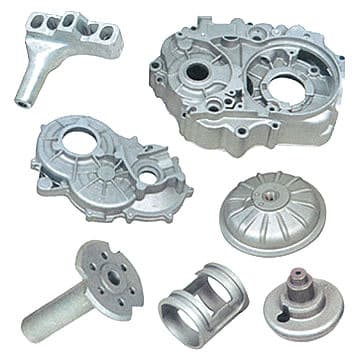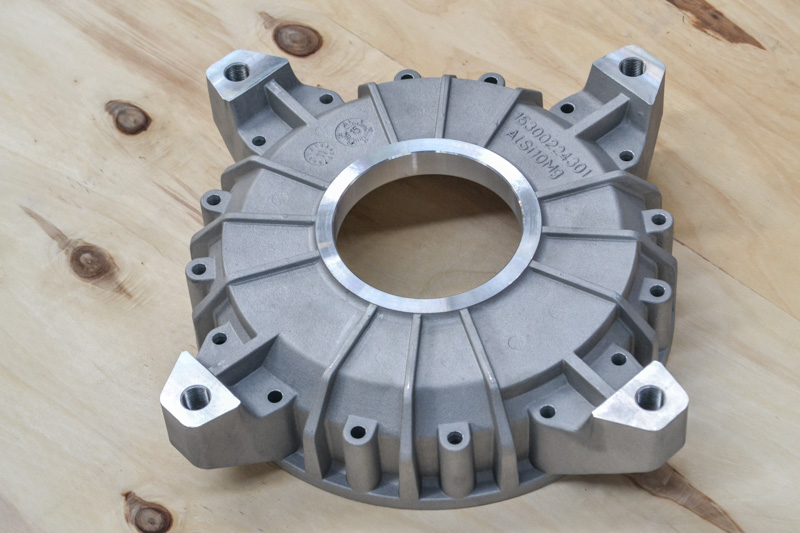Innovations and Fads Forming the Future of Aluminum Casting in Design Solutions
Technologies in aluminum casting are transforming design services. Developments in casting techniques, specifically high-pressure die casting and financial investment casting, are enhancing precision and design flexibility. Automation and wise innovations play an essential role in optimizing production performance. On the other hand, sustainability is coming to be a top priority, with environmentally friendly products obtaining grip. As these fads advance, they will redefine sector requirements and consumer expectations. What effects might these adjustments hold for the future of production?
Advances in Casting Methods

The Function of Automation in Aluminum Casting
Automation plays a pivotal function in improving the aluminum casting process by considerably raising manufacturing efficiency. By incorporating advanced technologies, suppliers can streamline procedures and minimize cycle times (Aluminum Castings). In addition, automation contributes to enhanced high quality control, ensuring consistent product requirements and reducing flaws
Enhanced Manufacturing Effectiveness
Reinventing the aluminum casting industry, automation greatly improves production efficiency. Automated systems enhance various stages of the casting procedure, lowering hand-operated labor and minimizing human mistake. High-speed robot arms can specifically take care of mold and mildews, guaranteeing constant and quick production cycles. Additionally, advanced computer algorithms enhance the organizing and monitoring of sources, bring about minimized downtime and boosted process. Automation likewise allows for real-time monitoring and changes, making it possible for manufacturers to respond swiftly to any operational problems. By implementing automated procedures, business can increase output while preserving cost-effectiveness. Eventually, this change in the direction of automation not just improves efficiency yet also placements manufacturers to fulfill the expanding demands of the market with better dexterity and sustainability.
Boosted Quality Assurance
A considerable advancement in aluminum casting is the assimilation of automatic quality control systems, which boost product consistency and reduce defects. These systems utilize advanced sensors and information analytics to keep an eye on the casting procedure in real-time, permitting prompt adjustments based on top quality metrics. Automation minimizes human mistake and raises the integrity of examinations, making certain that each part fulfills rigid specs. By carrying out device knowing algorithms, suppliers can forecast prospective failures and proactively address issues prior to they intensify. This not only enhances the overall top quality of aluminum items yet also simplifies the manufacturing process, causing raised effectiveness and cost savings. Ultimately, improved quality assurance via automation stands for a transformative action in the aluminum casting market.
Smart Technologies and Market 4.0 Integration
The assimilation of smart technologies and Industry 4.0 in aluminum casting is revolutionizing production processes. With the Internet of Points (IoT) enhancing real-time surveillance, automation and robotics are simplifying procedures, while data analytics provide essential insights for optimization. These developments are setting brand-new standards for effectiveness and precision in the market.
IoT in Casting Processes
Exactly how can the assimilation of IoT innovations improve the effectiveness and accuracy of aluminum casting processes? The application of IoT in casting makes it possible for real-time monitoring of temperature, pressure, and other important specifications, ensuring suitable conditions throughout manufacturing. Sensing units connected to the cloud can gather and analyze data, assisting in anticipating maintenance and decreasing downtime. By using smart algorithms, producers can determine abnormalities that may lead to problems, consequently boosting quality assurance. On top of that, IoT technologies make it possible for smooth communication between devices, permitting coordinated procedures and source optimization. This interconnectedness not just simplifies operations yet also boosts decision-making capabilities, ultimately resulting in considerable expense savings and greater performance in aluminum casting procedures.
Automation and Robotics Advancements
While the assimilation of automation and robotics is changing the aluminum casting sector, innovations in wise modern technologies and Sector 4.0 are driving extraordinary effectiveness and precision. Automated systems now handle recurring jobs, minimizing human mistake and enhancing manufacturing rates. Robotics in casting procedures permits enhanced handling of complicated shapes and fragile elements, making sure constant quality. Additionally, making use of joint robotics, or cobots, improves worker security by taking control of unsafe procedures. Smart technologies assist in real-time tracking and adjustments, enhancing manufacturing lines without hand-operated treatment. As these innovations evolve, they develop a much more nimble and responsive production atmosphere, enabling companies to adjust swiftly to market needs and improve overall competition in the aluminum casting market.
Data Analytics for Optimization
As automation and robotics proceed to reshape the aluminum casting sector, the consolidation of data analytics becomes an essential element of Smart Technologies and Industry 4.0. By leveraging big datasets generated throughout the manufacturing process, suppliers can recognize inefficiencies, optimize process, and enhance product high quality. Advanced algorithms and artificial intelligence tools make it possible for predictive upkeep, lessening downtime and reducing operational prices. Additionally, real-time information evaluation supports notified decision-making, permitting for nimble feedbacks to market demands. The combination of data analytics not only enhances manufacturing procedures yet additionally cultivates technology in have a peek here product advancement. As the sector evolves, embracing data-driven approaches will be vital for firms intending to maintain competitive benefits and achieve sustainable development in the aluminum casting field.
Additive Manufacturing in Aluminum Solutions

Additive manufacturing speeds up the prototyping process, allowing quick model and design optimization. It helps with the personalization of components, satisfying certain customer demands without the constraints of conventional casting methods. The assimilation of advanced software application tools aids in replicating and improving layouts before production, guaranteeing effectiveness and precision. As the aluminum casting landscape progresses, additive production stands out as a transformative force, promoting advancement and opening new avenues for engineering remedies throughout numerous markets.
Lasting Practices and Recycling Initiatives
Sustainable practices and recycling campaigns are coming to be progressively vital in the aluminum casting market, provided the expanding focus on ecological obligation. Producers are adopting methods that reduce waste and power usage, thereby decreasing their carbon footprint. One noticeable fad is the usage of recycled aluminum, which calls for significantly less power to procedure contrasted to primary aluminum manufacturing. This shift not just preserves all-natural sources but additionally decreases greenhouse gas discharges.
On top of that, ingenious casting techniques, such as die-casting and sand casting, are being optimized for sustainability, enhancing product efficiency. Companies are additionally spending in closed-loop systems that facilitate the reprocessing of scrap steel produced throughout manufacturing. Cooperations with recycling companies are promoting a more reliable recycling framework, ensuring that aluminum items have a longer lifecycle. Jointly, these efforts emphasize the market's dedication to sustainability while meeting the expanding need for eco responsible options in read design applications.
Lightweight Materials for Enhanced Performance
The aluminum casting sector is not just concentrating on sustainability but also on the growth of lightweight materials that enhance efficiency throughout numerous applications. These materials are progressively important in industries such as vehicle, aerospace, and customer electronics, where decreasing weight can cause boosted gas efficiency and general efficiency. Advanced aluminum alloys and compounds are being crafted to attain exceptional strength-to-weight proportions, making it possible for manufacturers to create components that are both robust and lightweight.
Technologies in casting strategies, such as high-pressure die casting and financial investment casting, promote the manufacturing of intricate layouts while minimizing product waste. This change in the direction of light-weight products is not only changing item styles however likewise driving affordable benefits in performance and effectiveness. As industries remain to prioritize weight decrease, the need for innovative aluminum casting remedies will likely expand, placing lightweight materials as a keystone of future design technologies.
Fulfilling the Needs of Eco-Conscious Consumers
As consumers increasingly focus on eco-friendliness in their purchasing choices, the aluminum casting market is adapting to meet these evolving needs. Producers are now concentrating on lasting methods, such as utilizing recycled aluminum, which substantially minimizes energy intake and greenhouse gas discharges compared to key aluminum manufacturing. Aluminum Castings. This shift not just conserves natural deposits however also allures to ecologically aware customers
Additionally, ingenious casting strategies are being developed to reduce waste and improve power efficiency during manufacturing. Companies are likewise checking out eco-friendly finishes and environmentally friendly additives to better minimize their ecological effect.
In addition, openness in supply chains is becoming necessary, with brands supplying information concerning their sourcing and making processes. By aligning with the worths of eco-conscious customers, the aluminum casting industry is positioning itself for a lasting future, demonstrating that ecological obligation can exist side-by-side with premium design solutions.
Often Asked Concerns
What Industries Primarily Utilize Aluminum Casting Solutions?
Aluminum casting options are largely made use of in vehicle, aerospace, and durable goods markets. These industries gain from aluminum's lightweight buildings, deterioration resistance, and adaptability, making it an excellent option for different applications and parts.
Just How Does Aluminum Casting Contrast to Other Metal Casting Approaches?
Light weight aluminum casting offers light-weight buildings, superb rust resistance, and good thermal conductivity contrasted to various other metal casting techniques. Aluminum Castings. Its convenience and effectiveness make it a recommended choice in numerous applications, specifically in auto and aerospace markets
What Certifications Are Very Important for Aluminum Casting Manufacturers?

What Are Usual Issues in Aluminum Casting and Their Reasons?
Common issues in aluminum casting consist of porosity, shrinking, and surface imperfections. These concerns commonly develop from improper putting methods, inadequate temperature level control, and contamination, influencing the structural integrity and aesthetic quality of the last item.
How Can I Select the Right Aluminum Alloy for My Task?
Choosing the best aluminum alloy entails thinking about factors such as mechanical residential or commercial properties, deterioration resistance, thermal conductivity, and application demands. Evaluating these standards assists ensure peak his comment is here performance and long life for the particular task concerned.